|
- Catalog (in stock)
- Back-Catalog
- Mail Order
- Online Order
- Sounds
- Instruments
- Projects
- History Face
- ten years 87-97
- Review Face
- our friends
- Albis Face
- Albis - Photos
- Albis Work
- Links
- Home
- Contact
- Profil YouTube
- Overton Network
P & C December 1998
- Face Music / Albi
- last update 03-2016
|
1. Kanyonza - lullaby - Ankole region - 11:02
2. Ngaali - lullaby - Buganda region - 13:32
3. Sii kano akanyonyi - lullaby - Buganda region - 11:29
4. Sirikawo omwana - lullaby - Buganda region - 13:52
5. Ogyendegye - dirge song - Ankole region - 9:24
6. Masejere - dirge song - Buganda region - 10:08
- With members from the Naggalabi Indigenous Theatre (NIT), a community of artists with a centre in Naggalabi for local, traditional and contemporary arts and crafts. The institution was founded by Sylvia Namulema Kigula and Eric Jjemba Lutaaya and is located in Nsangi su county Wakiso district, Uganda.
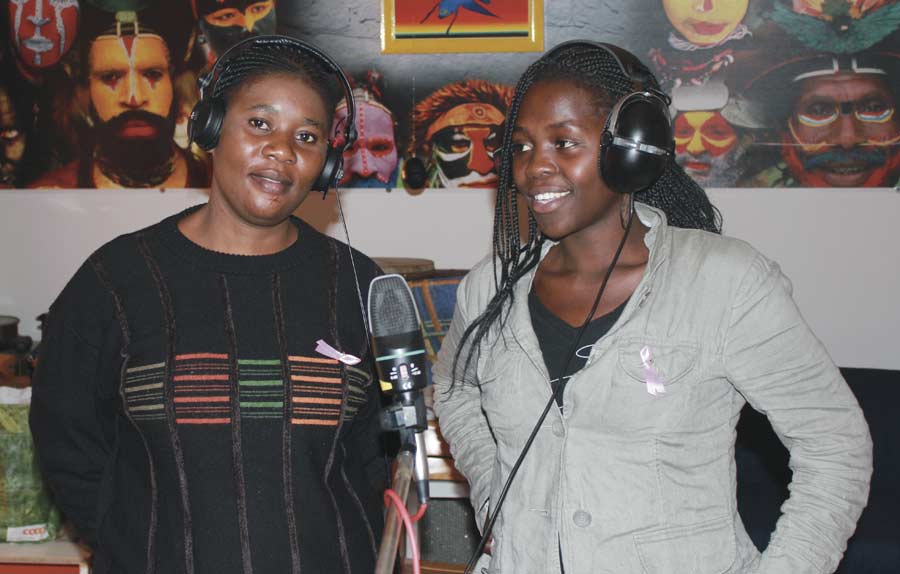 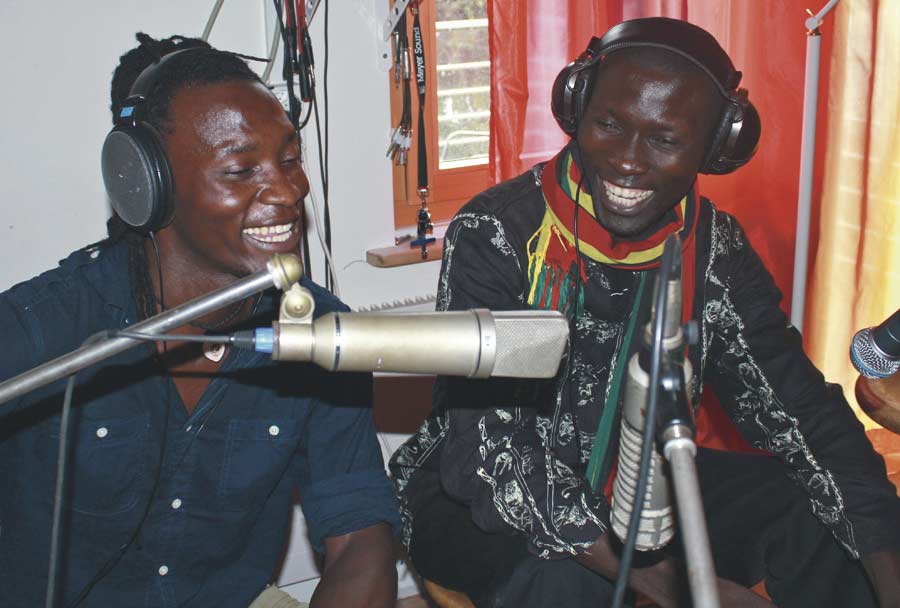
Sylvia, Ritah - Israel, Eric
Africa is inhabited by different ethnic groups, each with a musical tradition of its own. This is a rich traditional music heritage that has been orally transmitted from generation to generation for centuries. Despite external influences, the majority of these ethnic groups continue to value and practice their respective traditional musical styles, which in turn have to establish strong musical and cultural identities and continue to do so.
Ugandan music is generally rhythmic and the complexity of these rhythms varies due to the difference between the ethnic groups. These differences are also reflected in the varied instrumentation. Some musical genres are played on simple instruments, while others, especially the dance music, are played in ensembles of complex instrumental formation. African music is usually pentatonic, but a few tribes also use a hexatonic scale. Most of the Ugandan vocal music is accompanied by traditional instruments. The literature embedded in vocal music is purposely meant to transform the social communities, i.e. in their structural adjustment.
Although Uganda is inhabited by a large variety of ethnic groups, a broad linguistic division is usually made between the Bantu-speaking majority, who lives in the central, southern and western parts of the country, and the non-Bantu speakers, who occupy the eastern, northern and north-western part of the country (these may be sub-divided into Nilotic and Central Sudanic peoples).
- more information about Uganda the country and the people see: Uganda the country and the people
The Bantu people
The word Bantu itself, incidentally, simply means "human beings". These tribes all have Bantu as a core language in common, while their own languages usually comprise many dialects and variations. The ethno-linguistic Bantu group is most commonly said to have its origins in Western Africa (Cameroon). They are part of the Niger-Congo language family and have strong ancestral affinities with a group of languages being spoken today in southeastern Nigeria. The Bantu came from Central Africa, from where they began to expand to other parts around 2000 BC. These migrations are believed to have been the result of an increasingly settled agricultural lifestyle: although needing little land (far less than herding cattle use), land had to be fertile and well watered for cultivation to be a viable alternative. Population pressure in Central Africa may therefore have prompted the first Bantu migrations.
Bantu-speakers had entered southern Uganda probably by the end of the first millennium A.D. and they had developed centralized kingdoms by the fifteenth or the sixteenth century. Their languages are classified as Eastern and Western Lacustrine. The Western form comprises the area surrounding East Africa's Great Lakes (Victoria, Kyoga, Edvard, and Albert in Uganda). To the Eastern group belong the Baganda people (whose language is Luganda), also included are the Basoga, the Bagisu people, and many smaller societies in Kenya, Tanzania, and at the Zambezi River where the Monomatapa kings built the famous Great Zimbabwe complex.
The Bantu society
It seems that a long time ago many Bantu societies were organised along matrilineal lines and were governed by women; a whole heap of oral legends testifies to this, and female founding ancestors - where they exist in tradition - are as venerated and respected as their male counterparts.
Being a settled culture, the Bantu were inherently at risk of attack from the mobile nomadic Nilotic and Cushitic cattle and camel herders such as the Maasai, Borana (Oromo) and Somali, and as a result many Bantu societies became characterised by their defensive nature. Bantu groups lived on open land (ideal territory for the herders), having preferred, for both economic (agricultural) and defensive reasons, to occupy the less accessible highland regions. Settlements were built with the greatest attention to defence and were also well concealed: Europeans found they could be walking only metres from a settlement without knowing of its existence. Some tribes, like the Kikuyu, became experts at adapting and adopting to new realities, and rarely resorted to conflict. Others, like the Chuka, developed an array of inventive defensive measures, ranging from ingenious traps to tree houses and fortifications. Almost all the Bantu groups also adopted a rigid system of age-sets (an idea possibly borrowed from the Nilotic or Cushitic peoples they came across), in which all people of similar age were initiated into an age-set, which together progressed through clearly defined phases of social responsibilities, functions and status, from initiation, through warriorhood, marriage and elderhood to death. The system ensured the cohesion of society, as well as enabling the development of the warrior system, by which all the young men of a given society would, shortly after initiation to adulthood and their age-set, take up the role of defending the entire society.
Nowadays, the Bantu's reliance on agriculture and latterly trade has meant that they are by far the richest people, at least in monetary terms. The downside is that their settlements are inevitably densely populated, a problem which has grown acute over the last few decades.
- Songs and Dances of Bantu Women
The music of women in Bantu tribes is quite often part of the fabric of expression, which tells us who they are, not individually, but as a group - not in challenge to their culture, but in harmony with and support of the dominant and dynamic patterns of their culture. The songs and dances can be understood fully only by a tribe member, but we can benefit from an approach that looks at the textual content, the style (which includes their approach to composing), and the function of the songs and dances.
There is a conflict of presenting and, no doubt, mis-representing the dances and songs that have been extracted from the Bantu cultures. The weight of this wrong is proof to the vital interconnectedness of music and ways of life and meanings in Bantu culture. This has been said of many African cultures. Some Bantu-language have an expression for this loss of value in such an extraction: "You can take a feather from a bird, but when you get home that will not make you fly." In this way, music reflects a deep belief in the power of music to keep their life and culture alive. The traditional songs in women's lives, which they accompany, give proof for this. Thus, what we can see of the music and dance is out of context, but nonetheless all of its elements and expressions are purely reflective and confirming of life as it is in the culture of its origin. Also, we would have myopic view of women in Bantu cultures if we did not examine the African musical sensibilities that are the broader attitude towards music within culture. "Like a ritual or a musical event, an African community, too, is basically an ordered way of being involved through time. Africans rely on music to build a context for community action and, analogously, many aspects of their community life reflect their musical sensibility". Conventional to Western understanding of music is the identification of a work or song as a production of a single composer. However, composership in the African music system is not usually known to be authored by a particular individual. Either all the music is truly collaborative (not the case) and/or it is not important that individuals are credited with its creation. Music is often understood as a product of divine as well as mundane natural rhythms that are interpreted by villagers collectively. Again, music does not form a separate entity (from dance and from the holistic and daily culture); it is a communal production. Women, especially, have the solidarity of the other women and do not need to take individual credit for the composition they have created. Also, much of the song material is retained from generation to generation. The security of the form and the song allow for some freedom within it. The structure is so well known that individual women, especially dominant in voice, will improvise above that and thus transform aspects of the fabric of that song. The women who live this music do not seek originality but harmony. Especially in the group work songs it is clear that knowing the song and how it helps one to go about one's work in the village is more important that who first sung the melody. African women derive power and strength from social structure. It seems clear that we often consider women who defy social standards to be most powerful. An African woman expresses in her music that she is empowered by her positions as fixed by her culture. The song or dances, in their lyrics and in their place within a woman's world, provide an affirmation of identities such as mother, tiller of the earth, grinder of meal, midwife, socializing teacher or elder, or spiritual guide. The songs can be explicit messages to the community or a particular part of the community. They can be functional, providing necessary rhythms for human activity. Also, they can be narrative of an ongoing event or of well-known individuals. The women are the guardians of the life circle, from birth, through productivity and to death and again to birth. Musical elements that reflect the importance of a song within the unity of village women include: call and response, reassurance of participation (common inconverstion, too), apart-playing. "Africans respect ritualized social arrangements to externalize and objectify their sense of relationship because if a relationship is to be meaningful to them, the recognition one person gives another must be visible outside their own private involvement."
- Songs of the Bantu people
- Lullabies - The syllables (or vocals) are soothing and repetitive. There is some word painting in that the lull and the sleep lyrics fall and lilt in the vocal line. We do hear the "rhythms of sleep", though perhaps for lack of cultural similitude the song sounds less subdued than we are accustomed to hear in a lullaby. A part of the text says, "Don't you dance on your feet, they must be lulled and feel the rhythms of sleep." The child is dependent on the mother (on whose back she rests) for mobility. In the culture of this song children are not allowed to cry if they can possible help it. This song seems to be especially insistent for that reason. The lullaby is functional and expressive of the woman as mother - socializer and caretaker.
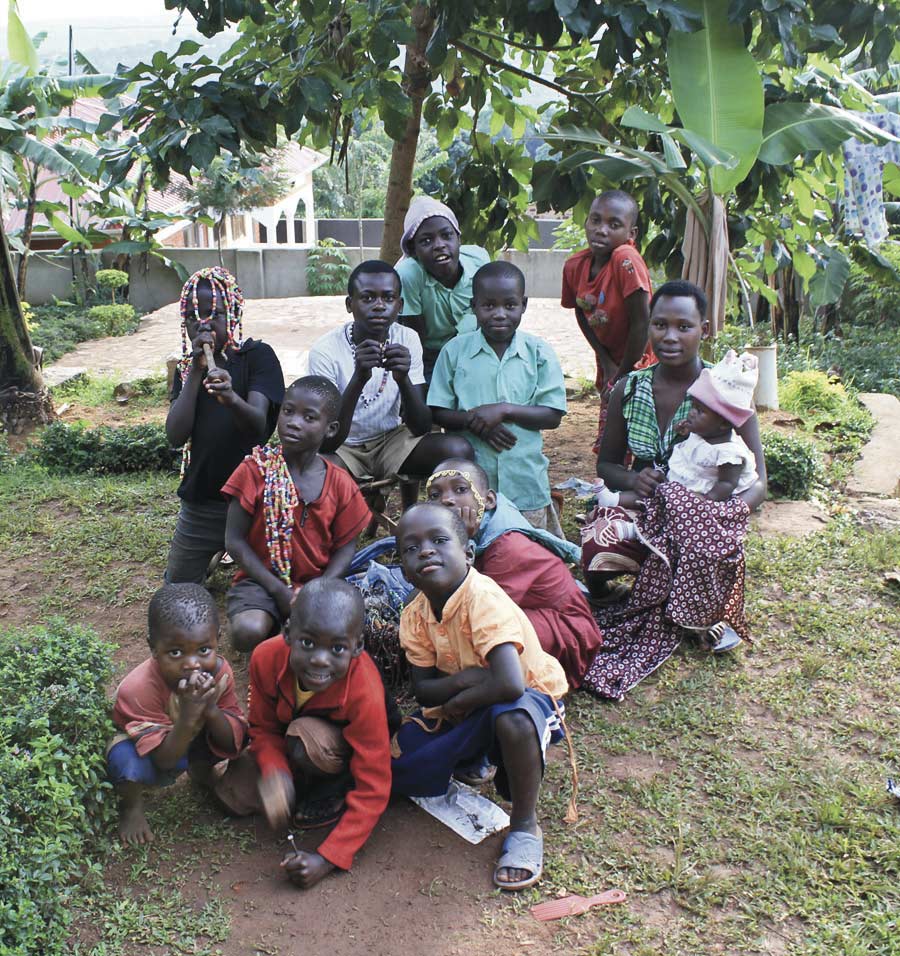
Children from Naggalabi Buddho
1. Kanyonza - Early morning bird - of the Banyankore people (Bantu)
- Ritah Kobusinge - lead voice, backing voice
- Sylvia Namulema Kigula - backing voice
- Israel Kalungi - adungu (bow harp), endingidi (tube fiddle)
- Eric Lutaaya Jjemba - backing voice
This song praises this early morning bird that wakes up all the herdsmen to milk the cows. Its voice sounds beautifully.
2. Ngaali - Crested crane - of the Baganda people (Bantu)
- Israel Kalungi - lead voice, adungu (bow harp)
- Sylvia Namulema Kigula - backing voice
- Eric Lutaaya Jjemba - backing voice
- Ritah Kobusinge - backing voice
This song praises the beauty of a crested crane. It is also told that the birds harvest the sorghum the people have grown.
3. Sii kano akanyonyi - Go away, you bird - of the Baganda people (Bantu)
- Israel Kalungi - lukembe (thumb piano)
- Ritah Kobusinge - lead voice
- Sylvia Namulema Kigula - backing voice
- Eric Lutaaya Jjemba - backing voice
A young girl chases birds from millet that is being dried in the sun.
4. Sirikawo omwana - Don‘t cry, baby - of the Baganda people (Bantu)
- Sylvia Namulema Kigula - lead voice
- Eric Lutaaya Jjemba - lead voice, backing voice
- Israel Kalungi - endingidi (tube fiddle), voice (baby cries)
This song soothes the crying baby to stop and sleep as they wait for the mother to come back from digging so that she breast feeds the baby.
- Dirge songs (lament) - Even on the occasion of death, a woman is given the sacred right to sing the dirge. This is a Bantu cultural requirement of women for several days after a death in the family.
5. Ogyendegye - You have gone - dirge song by the Banyankore people (Bantu)
- Sylvia Namulema Kigula - lead voice
- Eric Lutaaya Jjemba - backing voice, mourners in the background
- Israel Kalungi - backing voice, mourners in the background
- Ritah Kobusinge - backing voice, mourners in the background
The deceased`s children and relatives sing this song as they lament that he has gone and they cannot believe that they will never see him again. This is done until he is taken to the burial grounds.
6. Masejere - Wearing away - dirge song by Baganda people (Bantu)
- Sylvia Namulema Kigula - lead voice, backing voice
- Israel Kalungi - backing voice, engalabi (long drum)
- Eric Lutaaya Jjemba - backing voice, embuutu (big drum), ensaasi (shakers)
- Ritah Kobusinge - backing voice
This dirge song is sung by a dying woman who agrees that sickness has overpowered her, and she gives away her belongings. She eventually dies and they burry her with despite of the good things she had. In this way, everyone who dies is buried - even if he was very rich.
- The Baganda people make up the largest ethnic group in Uganda. (The name Uganda, the Swahili term for Buganda, was adopted by British officials in 1884 when they etablished the Uganda Protectorate, centered in Buganda). They speak a Bantu dialect called Luganda belonging to the Niger-Congo family. Like many other African languages, it is a tonal language which means that some words are differentiated by means of pitches. Words that are spelled in the same way, however, have a different meaning. It is a language that is rich in metaphors and proverbs.
Their music is mainly slow with more emphasis on a regular meter. It is composed of contrasted lyrics and yodles (flactuating vocal lines). Since they are the origin of the Negro people, they have a huge variety of song forms such as; lullabies, historical songs, work songs, ceremonic songs, praise the kings (royal songs), wedding songs, etc. Their scale is purely pentatonic. Most of the vocal lines are in a responsarial form, solo form and chorus form. Since these songs are vocal dominant, they are basically meant to deal with social transformation. Funerals are major ceremonial and social events.
- The Banyankore people (Ankole – Nkole) –Their vocal music is characterised by old type poetry recitals which in many cases signfy bravery, elongated vocal lines in imitation of the mowing cattle. Their vocal melodies are mainly responsorial in nature and at times polyphonous.
- more information about Bantu people see: The Bantu poeple
Instruments
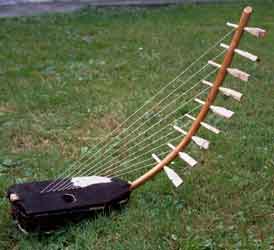 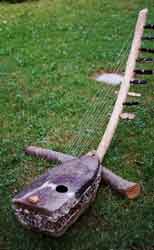
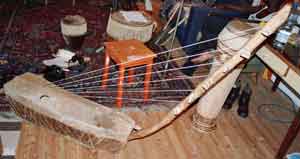
Adungu bass
|
- Adungu - bow harp - arched harp - string instument
The adungu is a nine-string arched (bow) harp of the Alur people of northwestern Uganda. It is very similar to the tumi harp of the neighbouring Kebu people, and it is also used by the Lugbara and Ondrosi tribes in this northwestern region around the Nile. The harp is used to accompany epic and lyrical songs, and it is also used as a solo instrument or within ensembles. Players of arched harps have had a high social status and are included in royal retinues. Nowadays they also play in churches.
The adungu consists of an arched neck, a wooden resonator (sound box) in which the neck is fixed, and a series of parallel strings of unequal lengths that are plucked. The strings are fixed at one end to the resonator and run at an oblique angle to the neck, where they are attached and tuned with pegs.
The first, second, and third strings are tuned in octaves with the sixth, seventh, and eighth respectively. In traditional music the instrument is tuned in a pentatonic (five-note) scale, but it can also be tuned in modern style to a diatonic scale.
|
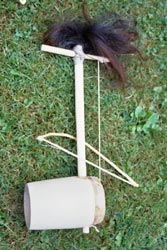
|
- Endingidi - tube fiddle - one-string-fiddle - string instrument
This instrument is popular in the Buganda, Busoga, Ankole, Kigezi, western Nile, and Acholi regions. It consists of a single string, which is attached to a flexible stick and will sometimes have a resonator. Unlike other single-string instruments, it is played with a bow.
|

|
- Akadongo – thumb piano
Many different names exist for this instrument; kalimba, sansa, and mbira are the most common ones. It consists of a series of flexible metal or cane tongues of varying lengths fixed to a wooden plate or trapezoidal sound box. Nowadays the resonator is made of kiaat wood, and the tines are made of high-quality spring steel. The musician holds the instrument in both hands and uses his thumbs to pluck the slightly upturned free end of the tines. The number and arrangement of the tines, or lameliae, vary regionally. The instrument accompanies a repertoire of "songs for thought," or laments, sung by both men and women.
In Buganda the instrument is known as "akadongo kabaluru" or "little instrument of the Alur tribe" from the northwest Nile region.
|
Drums in African tradition bring the power that drives a performance. Music is not merely entertainment, but it is ultimately bound to visual and dramatic arts as well as the larger fabric of life. Drums may be used for "talking"; that is, sending information and signals by imitating speech. Many African languages are both tonal (that is, meaning can depend on pitch inflections) and rhythmic (that is, accents may be durational), giving speech a musical quality that may be imitated by drums and other instruments. Drumming music and dance are almost always an accompaniment for any manner of ceremony; birth, marriages, funerals.
Engoma (Uganda drumset - percussion instrument) - While larger versions of this drum are traditionally hand-carved from old-growth hardwood trees, now these drums are made with pinewood slats tied together like barrels. Smaller drums are laminated and turned on a lathe and may be provided with a rope carrying the handle. All these drums have heads made from hide held by hardwood pegs hammered into the side of the drum.
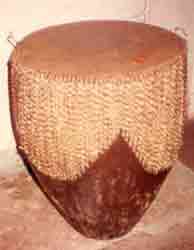
|
- Embuutu - big drum - percussion instrument
|
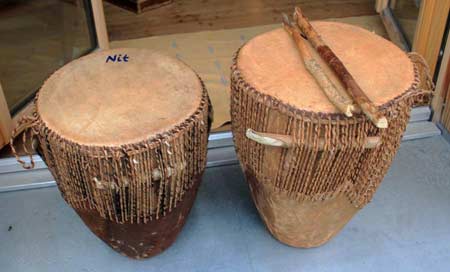
|
- Namunjoloba small drum - percussion instrument
|
 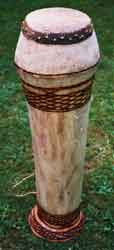
|
- Engalabi - long drum - percussion instrument
This traditional drum has a head made of reptile skin nailed to a wooden sound body. The engalabi from the Buganda region has an important roles in ceremonies and in theater. It is called "Okwabya olumbe". This is the installation of a successor to the deceased, thus the saying in Luganda (in Buganda a Bantu dialect) "Tugenda mungalabi", meaning we are going to the engalabi, that is, long drum. Rule in playing the drum is the use of bare hands.
|

|
- Ensaasi - shakers - percussion instrument
Shakers are made in pairs from gourds or shells, sometimes with stick handles, and are used to accompany other traditional instruments in Uganda. The central and northern (Alpaa) regions have shakers that produce a continuous sound as beads move from side to side in the gourd or shell. Generally, these shakers produce sounds by many small objects, such as pebbles, rattling together inside the body.
|
Revised by Hermelinde Steiner 2013
PageTop

|
